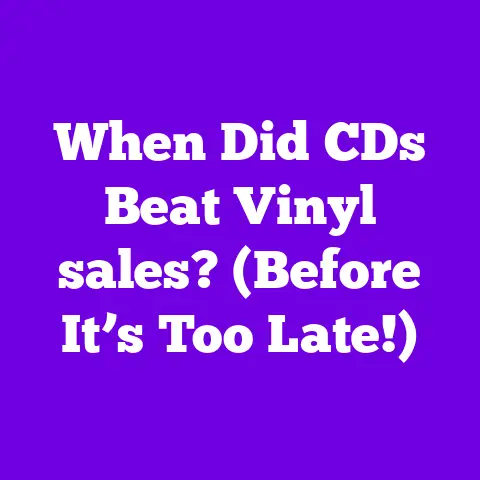When Do Snowboards Go On sale? (Shred This Deal!)
The crisp mountain air, the exhilarating rush of carving down a fresh powder run – snowboarding is more than just a sport; it’s an experience.
But as much as we love shredding the slopes, it’s impossible to ignore the environmental impact of our gear.
That’s why, increasingly, snowboarders like myself are looking for eco-friendly options.
We want to minimize our footprint while maximizing our fun.
The good news is that the snowboarding industry is responding.
We’re seeing a surge in brands committed to sustainable practices, from using recycled materials to implementing eco-conscious manufacturing processes.
But buying eco-friendly doesn’t have to break the bank.
Knowing when snowboards go on sale is crucial, especially when you’re aiming for sustainable brands that might have a slightly higher price point initially.
So, when exactly can you snag those sweet deals on snowboards in 2025, and how can you ensure you’re supporting brands that are doing their part for the planet?
Let’s dive in and uncover the secrets to scoring a great deal on an eco-friendly board without sacrificing performance or principles.
I will show you the timeline of snowboard sales and the best times to purchase them in 2025, while ensuring a connection to eco-friendly brands and products.
Section 1: Understanding Snowboard Sales Cycles
The snowboard market, like any other retail sector, operates on a cyclical pattern.
Understanding this rhythm is key to finding the best deals.
Generally, the snowboard sales cycle is dictated by the seasons, manufacturer release schedules, and key retail events.
The General Timeline:
- Late Summer/Early Fall (August – October): This is when manufacturers traditionally release their new models for the upcoming season.
While you might be tempted to jump on the latest and greatest, this is generally not the time for deep discounts.
Think of it like buying a new car – the newest models command the highest price. - Pre-Season (October – November): As the snow begins to fall and anticipation builds, retailers start offering pre-season sales.
These can be decent opportunities, but the selection might still be limited, and discounts aren’t usually as steep as later in the season. - Peak Season (December – February): During the heart of winter, prices tend to be at their highest.
Demand is high, and retailers know they can sell at full price. - Late Season (March – April): As winter winds down, retailers start to clear out their inventory to make room for next year’s models.
This is when you’ll start seeing more significant discounts. - Post-Season (April – May): This is the sweet spot for bargain hunters!
Retailers are desperate to get rid of remaining inventory, leading to the deepest discounts of the year.
However, selection can be limited to leftover sizes and models.
Manufacturer Release Schedules and Pricing:
Manufacturers typically unveil their new snowboard lines in late summer or early fall (August to October).
This launch has a direct impact on the pricing of the previous year’s models.
As new boards hit the shelves, retailers mark down older inventory to make space.
This creates opportunities for savvy shoppers to snag last year’s tech at significantly reduced prices.
Key Events Influencing Sales:
Several key events can influence snowboard sales throughout the year:
- Trade Shows: Events like SIA Snow Show (usually held in January) can provide insights into upcoming trends and technologies.
While you can’t directly buy at these shows, they can give you an idea of what to expect in terms of new products and potential price drops on older models. - Major Snowboarding Competitions: The X Games, the Winter Olympics, and other major competitions often coincide with promotional events and sales from retailers looking to capitalize on the increased interest in snowboarding.
- Holiday Seasons: Black Friday, Cyber Monday, and end-of-year holiday sales are prime times for finding discounts on snowboards and related gear.
The Role of Retailers:
Retailers play a crucial role in the snowboard sales cycle.
They manage inventory, set pricing strategies, and run promotions.
Their decisions are influenced by factors like:
- Inventory Levels: Retailers need to balance having enough stock to meet demand during peak season with avoiding excess inventory at the end of the season.
- Competition: Pricing is often influenced by what other retailers are doing.
- Manufacturer Incentives: Manufacturers may offer incentives to retailers to promote specific models or brands.
Section 2: Key Sale Periods for 2025
Now, let’s get specific about the sale periods you should be watching in 2025:
- Pre-Season Sales (August-September): While not the deepest discounts, pre-season sales can be a good opportunity to snag a new board before the rush.
Keep an eye out for promotions tied to early-season snow reports or back-to-school events. - Black Friday and Cyber Monday Deals (November): These are two of the biggest shopping days of the year, and snowboard retailers are no exception.
Expect to see significant discounts on a wide range of boards and gear.
According to the National Retail Federation, Black Friday sales reached $9.8 billion in 2023, highlighting the potential savings available during this period. - Post-Season Clearance Sales (April-May): This is where you’ll find the absolute rock-bottom prices.
Retailers are eager to clear out their remaining inventory to make room for summer gear.
Be prepared for limited selection and potentially fewer size options.
Expected Discounts and Deals:
- Pre-Season: Expect discounts of around 10-20% off MSRP.
- Black Friday/Cyber Monday: Discounts can range from 20-50% off, with some doorbuster deals offering even greater savings.
- Post-Season Clearance: Look for discounts of 50-70% off, and sometimes even higher.
Eco-Friendly Brands and Sales:
Many eco-friendly snowboard brands participate in these sales events. Look for brands like:
- Arbor Snowboards: Known for their sustainable sourcing and use of bio-based materials.
- Lib Tech: Famous for their experimental designs and commitment to reducing waste.
- Jones Snowboards: Focused on creating high-performance boards with a low environmental impact.
These brands often offer discounts on their previous season models during Black Friday and post-season sales.
Strategies for Consumers:
- Do your research: Before the sales start, research the boards you’re interested in.
Read reviews, compare specs, and determine the right size and flex for your riding style. - Sign up for email lists: Many retailers offer exclusive deals and early access to sales for their email subscribers.
- Follow social media: Retailers often announce sales and promotions on their social media channels.
- Be ready to act fast: Popular boards and sizes can sell out quickly during sales events.
Section 3: Eco-Friendly Snowboard Brands to Watch in 2025
The good news is that there are a growing number of brands committed to sustainability.
These brands are using innovative materials, reducing waste, and supporting environmental initiatives.
Notable Eco-Friendly Snowboard Brands:
- Arbor Snowboards: Arbor has been a leader in sustainable snowboarding for over 25 years.
They use sustainably harvested wood cores, bio-based resins, and recycled materials in their boards.
They also partner with organizations like American Forests to plant trees. - Lib Tech: Lib Tech is known for its experimental designs and commitment to reducing waste.
They use eco-friendly materials like basalt fiber and bio-based resins, and they have a zero-hazardous-waste policy. - Jones Snowboards: Founded by legendary snowboarder Jeremy Jones, Jones Snowboards is focused on creating high-performance boards with a low environmental impact.
They use sustainably sourced wood cores, recycled materials, and bio-based resins.
They also partner with Protect Our Winters (POW) to advocate for climate action. - CAPiTA Snowboards: CAPiTA is committed to reducing its environmental impact through sustainable manufacturing practices and the use of eco-friendly materials.
Their Mothership factory in Austria is powered by 100% renewable energy. - Bataleon Snowboards: Bataleon emphasizes the use of sustainable materials and ethical manufacturing practices.
They are known for their innovative 3D shaping technology, which enhances the board’s performance while reducing environmental impact.
Unique Features:
- Arbor: Their use of sustainably harvested wood cores provides a smooth and responsive ride while minimizing deforestation.
- Lib Tech: Their Magne-Traction edges provide exceptional grip on icy conditions, reducing the need for harsh chemicals to melt ice.
- Jones: Their commitment to partnering with environmental organizations like POW demonstrates their dedication to protecting the mountains we love.
- CAPiTA: Their Mothership factory sets a new standard for sustainable manufacturing in the snowboard industry.
- Bataleon: Their 3D shaping technology enhances performance while reducing the amount of material needed to construct the board.
2025 Models and Expected Sales:
Keep an eye out for new models from these brands in 2025.
They often release updated versions of their popular boards with new features and improved sustainability.
Sign up for their email lists and follow them on social media to stay informed about upcoming sales and promotions.
Section 4: How to Choose the Right Board During Sales
Finding a great deal is only half the battle.
You also need to make sure you’re choosing the right board for your skill level, riding style, and environmental impact.
Considerations:
- Skill Level: Are you a beginner, intermediate, or advanced rider?
Beginners typically need softer, more forgiving boards, while advanced riders often prefer stiffer, more responsive boards. - Riding Style: Do you prefer riding in the park, carving groomers, or exploring the backcountry?
Different boards are designed for different riding styles. - Environmental Impact: Look for boards made with sustainable materials, such as sustainably harvested wood cores, recycled materials, and bio-based resins.
Assessing Quality and Sustainability:
- Check the materials: Look for boards made with sustainable materials like sustainably harvested wood, recycled content, and bio-based resins.
- Research the brand: Look for brands with a strong commitment to sustainability and ethical manufacturing practices.
- Read reviews: See what other riders are saying about the board’s performance and durability.
Tips for Research and Comparison:
- Use online resources: Websites like evo.com and backcountry.com offer detailed product descriptions and customer reviews.
- Visit local snowboard shops: Talk to knowledgeable staff and get their recommendations.
- Compare specs: Pay attention to factors like flex, shape, and sidecut.
Section 5: The Future of Eco-Friendly Snowboarding
The future of eco-friendly snowboarding is bright.
We’re seeing constant innovation in materials and technology, driven by consumer demand and industry initiatives.
Potential Trends:
- New Materials: Expect to see even more innovative materials, such as algae-based foams, mushroom-based composites, and recycled carbon fiber.
- Sustainable Manufacturing: More brands will adopt sustainable manufacturing practices, such as using renewable energy, reducing waste, and minimizing water consumption.
- Circular Economy: The industry will move towards a circular economy, where snowboards are designed to be easily repaired, reused, and recycled.
Consumer Demand:
Consumer demand for sustainable products is a major driver of change in the snowboarding industry.
As more riders become aware of the environmental impact of their gear, they’re demanding more sustainable options.
According to a study by Nielsen, 66% of global consumers are willing to pay more for sustainable brands.
Collaborations and Initiatives:
Several collaborations and initiatives are aimed at promoting sustainability in the snowboarding industry:
Supporting sustainable brands and practices is crucial for the future of snowboarding.
By making conscious choices about the gear we buy, we can help protect the mountains we love and ensure that future generations can enjoy the sport.
So, stay informed, do your research, and get ready to shred this deal in 2025!
You can make conscious choices that positively impact the environment while enjoying their snowboarding experience.






